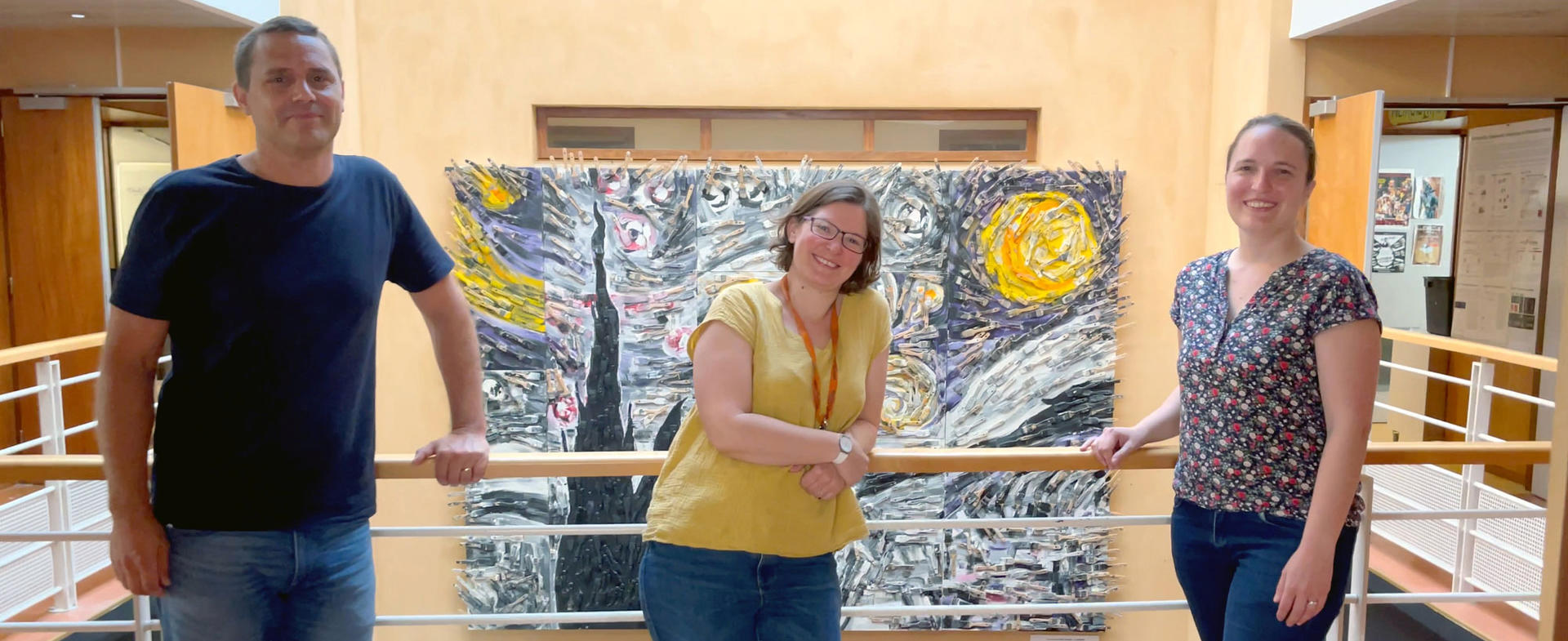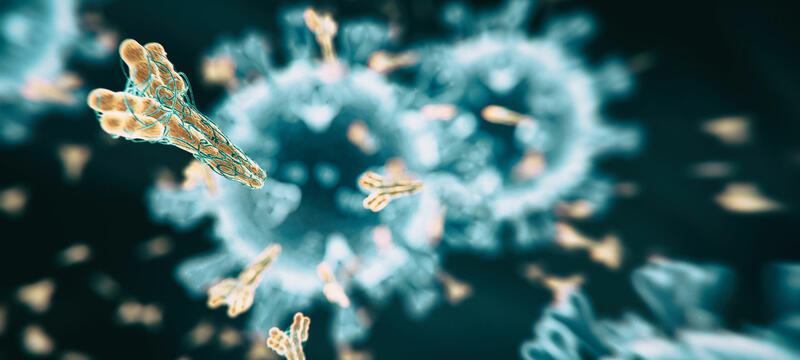40 years of HIV research: what have we achieved and where are we going?
Written by Anina Werner
04. November 2021
Research teams all over the world have been studying the human immunodeficiency virus (HIV) for almost four decades. So, where are we today? What do we already know, and what puzzles remain to be solved? We had the opportunity to discuss these and other questions with Gaël Petitjean, Research Engineer; Scarlette Abbou, Engineer; and Suzie Houssier, Post-Doctoral Researcher at the Centre National de la Recherche Scientifique in Montpellier.
Table of contents
Until the 1990s, HIV was a death sentence. Today, you can live a normal life when you're HIV-positive. How did we get here?
Gaël: You’re right, even though drugs were already available in the 90s, sadly, many people still lost the fight against HIV. The underlying reason can be found in the life cycle of the virus. Retroviruses, like HIV, have a single-stranded RNA genome, and once the virus has entered a host cell, the reverse transcriptase enzyme synthesizes complementary DNA (cDNA) from the retroviral RNA genome. As it's not efficient at making exact copies, mutations are introduced at every cycle. It was therefore only a matter of time until the virus developed a resistant mutation and no longer responded to previous therapies. Treatments nowadays combine several compounds targeting different steps of the life cycle of the virus, eliminating the problem of resistant mutations. This means that an HIV-positive person can live a normal life today, without transmitting the virus.
Suzie: However, adherence to therapy is crucial. As soon as someone doesn't take the medication daily, mutations can develop. That's why it is important to have regular checkups to detect possible mutations at an early stage, and adapt the treatment as required.
Can you explain more about why HIV-positive people must take medication every day? What happens if someone stops their treatment?
Gaël: The reason we only have a treatment and still no cure is the latent HIV reservoir. It consists of cells that have been infected but don't express the virus – as long as the medication is taken. The virus hiding in these cells cannot be recognized by the immune system or be targeted by the antiretroviral drugs. The number of reservoir cells is very low, between 1000 to 10 000 in the entire body, but it's sufficient to start a productive infection when treatment is interrupted or stopped. So, as soon as someone doesn't take the medication, there's a rebound. It will occur about one to two weeks after the cessation of treatment, even if the virus has been successfully controlled for years.
And your research focuses on finding and eliminating this reservoir?
Gaël: In our team, we try to identify biomarkers of reservoir cells. We believe that HIV impacts gene expression in these latently infected cells, and that we can detect them by finding biomarkers in the form of proteins. We've already identified some candidate markers and validated the results in patients. If we manage to find a set of biomarkers that allow us to detect all the reservoir cells and develop antibodies to target them, we could eliminate the HIV reservoir. Another approach to destroy the reservoir is the 'shock and kill' strategy. Some research teams, mainly based in the US, try to reactivate and eliminate the reservoir by stimulating the immune system and using antiretroviral drugs. It works well in vitro, but unfortunately not in vivo.
Scarlette: In addition to our research on biomarkers, we try to find the exact source of rebounds. To do so, we sequence the virus that is contained in reservoir cells and compare it to free viral RNA in the plasma. The challenge is to get enough reservoir cells to work on. Most of the reservoir cells aren't in the blood, but in tissues like lymph nodes or the gut. Getting such tissue samples would be invasive for patients, so we have to use blood samples and sort a huge number of cells just to get a hundred or so to work on.
Suzie: Another problem, which I'm currently working on, is that some steps of the virus’s replication are still unknown. For example, we know that the virus enters the cell nucleus of its host, but we don’t know how. We initially thought that the virus is too big, but advanced imaging technologies proved us wrong, and we can now see it entering the nucleus. We also know that it doesn't randomly integrate into the host genome. There are hotspots of integration, but we don’t know what directs it to these specific parts of the cell genome. A better understanding of such critical steps might enable us to block the virus from integrating into the genome, or to develop new drugs.
That sounds very promising. And are you also conducting research on a vaccine?
Gaël: Vaccines are the focus of other research teams. At the beginning, the scientific community thought: "HIV is a virus, we'll get a vaccine soon". But we were mistaken. HIV is way more complicated than any other virus. There are several reasons that make it difficult to develop a vaccine for HIV, notably its polymorphism. Vaccines lose efficacy when new virus variants develop, which is currently highlighted with the COVID-19 pandemic. And SARS-CoV-2 mutates very slowly compared to HIV. With HIV, you have a lot of viral sub-species in just one patient, so it will be hard to get an efficient vaccine.
Speaking of COVID-19. Has the pandemic set back your research?
Scarlette: For sure. Firstly, we weren't allowed to come to the lab at all. And when we returned, it was difficult to get essential things like gloves. Many suppliers only sold them to labs working on COVID-19. And some of us, Gaël, for example, even started working on SARS-CoV-2 instead of HIV for a certain period.
Gaël: Indeed. It was very satisfying to be able to contribute. On top of that, it was a completely different way to do science. It was a novel virus, so everything you did was a discovery, plus it was exciting to work on a short-term project for once.
Let's wrap up with a look into the crystal ball. Where will we be in 10 years thanks to your research and the work of other teams around the world?
Suzie: That's hard to say. In 2009, at a Sidaction meeting, a French organization fighting against HIV, a highly reputable expert said: "In five years, there will be a vaccine". But there is still no vaccine. One thing that changed in the last decade is that HIV-positive people can now take one pill containing all the different compounds, instead of taking several pills a day.
Gaël: And the PrEP, or pre-exposure prophylaxis, has been developed for people at risk. In the future, it might be possible to get a treatment once or twice per year instead of taking medication every day. And we will probably better understand the HIV reservoir and the replication cycle of the virus. But will there be a cure? Or a vaccine? Who knows, science is a matter of facts, not predictions.
Scarlette: What worries me with respect to the future is that young people don't seem to be aware of HIV anymore. We sometimes get blood samples of 16-year-olds who have recently been infected – that’s shocking and makes me wonder if we’re doing enough to educate the youth. It could be that they either forget about HIV, or think that there’s a cure. Even if HIV is only a chronic disease now, we should prevent infections whenever possible, especially because we can’t guarantee to find a cure in the next decade.
And if we look back at the past? Why did you choose to do research on HIV?
Scarlette: I'm passionate about DNA. HIV integrates into the genomic DNA of its host and evolves with it. The idea of doing research that can be used to develop therapies directly targeting the DNA fascinates me.
Suzie: For me, it's the microbes. I just love microbes. I first studied bacteria, then parasites, and finally viruses. A few years ago, when I had to decide between working on HIV or on a virus that infects animals, the choice was easy. HIV is a problem impacting people worldwide, and I want to contribute to solve it.
Gaël: When I chose to start to work in this field, it was to improve patient's lives. What fascinates me today is the following: viruses co-evolved with their hosts for millions of years, and today, HIV knows everything about us and our immune system. Although it's not a living-being, somehow, it seems to be 'smart', and knows much more about us than we know about it.
We hope that this will soon change thanks to your research shedding light on the unknown secrets of HIV. Thank you very much for your time and valuable insights.
Further reading:


























